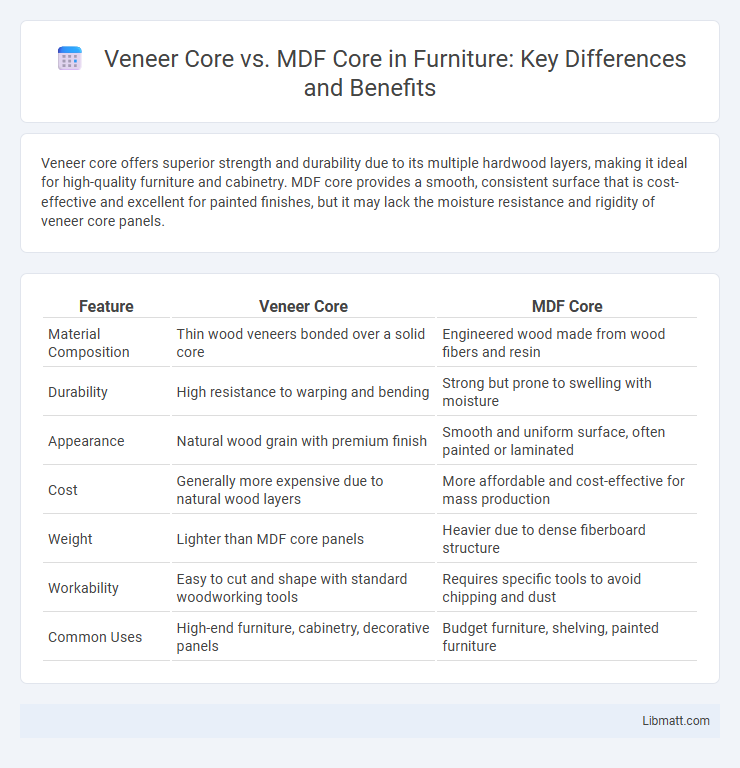Veneer core offers superior strength and durability due to its multiple hardwood layers, making it ideal for high-quality furniture and cabinetry. MDF core provides a smooth, consistent surface that is cost-effective and excellent for painted finishes, but it may lack the moisture resistance and rigidity of veneer core panels.
Table of Comparison
| Feature | Veneer Core | MDF Core |
|---|---|---|
| Material Composition | Thin wood veneers bonded over a solid core | Engineered wood made from wood fibers and resin |
| Durability | High resistance to warping and bending | Strong but prone to swelling with moisture |
| Appearance | Natural wood grain with premium finish | Smooth and uniform surface, often painted or laminated |
| Cost | Generally more expensive due to natural wood layers | More affordable and cost-effective for mass production |
| Weight | Lighter than MDF core panels | Heavier due to dense fiberboard structure |
| Workability | Easy to cut and shape with standard woodworking tools | Requires specific tools to avoid chipping and dust |
| Common Uses | High-end furniture, cabinetry, decorative panels | Budget furniture, shelving, painted furniture |
Introduction to Veneer Core and MDF Core
Veneer core plywood consists of thin hardwood veneers glued together in multiple layers, offering superior strength, stability, and resistance to warping compared to MDF core. MDF core plywood is made from medium-density fiberboard, providing a smooth, uniform surface ideal for veneering and painting but with less structural durability and moisture resistance than veneer core. Both materials serve as popular substrates in cabinetry and furniture making, each optimized for specific performance and aesthetic requirements.
What is Veneer Core?
Veneer core consists of multiple layers of thin wood veneers glued together with the grain of each layer alternating, creating a stable and strong plywood base ideal for laminated doors and cabinetry. This core type offers superior durability and resistance to warping compared to MDF core, which is made from compressed wood fibers and resin. When choosing door construction, your preference for genuine wood appearance and structural strength may make veneer core the optimal option.
What is MDF Core?
MDF core refers to Medium Density Fiberboard used as the central layer in engineered wood products, offering a smooth, consistent surface ideal for veneering and painting. It is made from wood fibers bonded with resin under heat and pressure, providing excellent stability, uniformity, and resistance to warping compared to other core materials. MDF core panels are widely favored in furniture and cabinetry manufacturing for their strength, affordability, and ease of machining.
Key Differences Between Veneer Core and MDF Core
Veneer core features a plywood base with thin wood layers, offering superior strength, durability, and natural grain appearance, making it ideal for high-end cabinetry and furniture. MDF core is made from finely ground wood fibers bonded with resin, providing a smooth, uniform surface that resists warping and is cost-effective for painted finishes. The key differences lie in construction materials, surface aesthetics, durability, and suitability for specific applications.
Strength and Durability Comparison
Veneer core provides superior strength and durability due to its layered natural wood construction, making it more resistant to warping, moisture, and impact compared to MDF core. MDF core is composed of fine wood fibers bonded with resin, offering a smooth surface but less structural integrity and susceptibility to swelling when exposed to water. Your choice should prioritize veneer core for applications requiring long-lasting performance and resistance to wear.
Weight and Handling Considerations
Veneer core plywood is generally lighter and more flexible compared to the denser MDF core, making it easier to handle and transport during construction or cabinetry projects. MDF core tends to be significantly heavier due to its composite wood fiber composition, which can affect the ease of installation and may require additional support in larger applications. Understanding these weight and handling differences helps you select the optimal core material that balances durability with practical usability for your specific woodworking needs.
Surface Finish and Appearance
Veneer core doors feature a natural wood veneer surface that provides an authentic wood grain appearance, offering a high-quality, elegant finish ideal for enhancing Your interior aesthetics. MDF core doors have a smooth, uniform surface that is perfect for consistent paint application and can be customized with various finishes but lacks the natural wood texture found in veneer. Choosing between the two depends on whether You prioritize genuine wood visuals or a smooth, paint-ready surface for Your project.
Cost Comparison: Veneer Core vs MDF Core
Veneer core cabinets generally cost more than MDF core cabinets due to the natural wood layers used in their construction, which provide enhanced durability and a premium appearance. MDF core cabinets offer a more budget-friendly option with smooth surfaces ideal for painted finishes but may lack the strength and moisture resistance of veneer cores. Your choice between veneer core and MDF core should balance cost considerations with desired quality and longevity in cabinetry.
Ideal Applications for Each Core Type
Veneer core is ideal for high-end cabinetry and furniture where durability and a natural wood appearance are essential, providing superior strength and stability. MDF core is better suited for painted finishes and interior doors or panels where a smooth, uniform surface is required for detailed designs or consistent paint application. Your choice between veneer core and MDF core hinges on whether you prioritize natural aesthetics with durability or affordability with a flawless finish.
Choosing the Right Core for Your Project
Veneer core offers natural wood layers that provide enhanced strength and superior screw-holding ability, making it ideal for high-quality furniture and cabinetry requiring durability and a premium finish. MDF core, composed of fine wood fibers, ensures uniform density and smooth surfaces perfect for painting and intricate machining, suitable for projects prioritizing cost-effectiveness and consistent texture. Assess your project's needs for strength, appearance, and budget to select between veneer core's natural appeal and MDF core's versatility.
Veneer core vs MDF core Infographic

 libmatt.com
libmatt.com